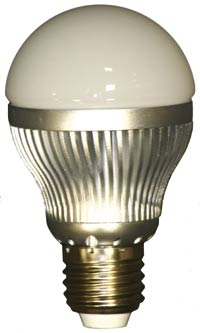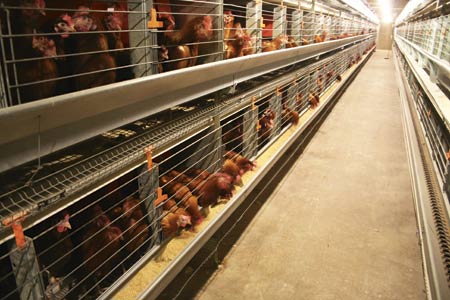New LED light offers welfare benefits to poultry flocks

A major breakthrough in the lighting of poultry housing should bring massive cost savings in power usage as well as improve the environment for birds.
The new Light Emitting Diode (LED) bulb – already proving a big success in large-scale trials – will avoid many of the stress or health problems that have been linked to failings in traditional methods of lighting, according to the manufacturer.
Until the development of this new LED lighting system by Greengage Lighting, the poultry industry has been reliant upon conventional tungsten filament and fluorescent lighting. Although both have been relatively low cost in terms of installation – although not necessarily in terms of power usage – both filament and fluorescent systems have a degree of inefficiency which can prove costly if they fail.
They have dimmability issues and have been linked to problems with bird behaviour.
While there has been a move towards the use of fluorescent strip lighting by many producers, there remains long-standing concerns over the area of light emittance from fluorescent strips which can also produce an excessive degree of infra-red light which has been linked to bird-to-bird aggression.

Greengage Lighting is well established as a producer of LED lamps and recently became aware of the economic and environmental potential of LED lighting to poultry producers, driven largely by producer concerns over the shortcomings of conventional lighting – both tungsten and fluorescent.
James Booth, director and co-founder of Greengage Lighting, says the company wanted to “make a big difference very quickly” to the poultry sector.
“We were aware that there were concerns in two main areas in poultry systems using conventional lighting. bird welfare was becoming increasingly important to producers and the energy consumption of conventional lighting was an area that we felt could be vastly improved,” says Mr Booth.
Having launched research into the poultry sector’s lighting needs, he admits the company was soon on a fast upward learning curve as they closely monitored how birds reacted to different sources of light.
“We knew we had to create a bulb that would meet the demands of birds when they are housed – both in rearing houses, caged and barn systems as well as birds on free range. We knew we had to develop a resilient bulb for the job but also one that emitted light that could be dimmed. That required circuitry that had to be developed.”
Development of the bulb has been undertaken in conjunction with Noble Foods which has installed the lighting system on three of its sites carrying 30,000 laying birds.
Mr Booth adds: “We believe the lamp can bring substantial cost savings – up to 90% – in power usage to poultry producers. Volume uptake will obviously help bring down the price of the bulbs, which is currently volume dependent, but the current cost is around £20 a bulb. We will be introducing leasing packages to producers to help reduce initial installation costs.”
Each of the lamps has a guaranteed lifespan of 25,000 hours. Mr Booth stresses that development of the new bulb was focused on achieving the perfect balance of light output and “colour-rendering index” for housed poultry.
It is well documented that infra-red light can have an adverse effect on bird behaviour leading to aggression and feather pecking. The development of the LED bulb sought to significantly reduce the level of infra-red light emissions compared with those given off from incandescent light bulbs and fluorescent lighting.
The LED bulb is less likely to be affected by vibrations. It can be fully dimmed and the heat emitted is 50% less than from conventional bulbs. It is non-toxic and can be safely re-cycled.
“We were also very conscious of the safety aspect of the LED bulb. There have been suggestions that fluorescent lighting, when broken, can generate vapours as a result of the mercury contained in the system. From a Health and Safety aspect, poultry workers are advised to vacate any building for 15 minutes if a fluorescent system is broken.”
Case study: Noble Foods
Noble Foods has been testing the Glo Agrilamp on three sites for the last nine months, accommodating a variety of birds from day-old to 16-week-olds, as well as free-range layers.
Nigel Youd, environmental manager for Noble Foods, says the company had been looking at ways of improving the welfare of birds at all stages of the production system and also the carbon footprint of its sites.
“The type of lighting we were using in our sheds – tungsten lighting – was not the type of lighting most suited to the birds’ welfare. The wavelength of light that we see is not the same for poultry and we had to be aware of that as we looked for new alternatives.”
Noble Foods had looked at fluorescent lighting and had evaluated this system for two years. “But there was an obvious problem with the dimmability of the fluorescent system and we could only dim these lights by 50% which we felt was a big problem. Although we had been able to reduce the 40W tungsten bulb to a seven watt fluorescent, the inability to adequately dim remained.”
Results from the first tests using the LED lighting system in Noble Foods’ laying units had shown that the system had helped lift egg production and benefitted bird behaviour.
When the LED bulbs were installed in a rearing site it was noted that chicks located their food source much more rapidly leading to an increase in body weight for age compared with chicks reared on conventionally lit sheds. Mortality rate was also reduced by 0.5%.
Free-range and colony system units run by Noble Foods and lit with the LED bulbs showed that birds were calmer and demonstrated less tendency for feather pecking and aggression.
Noble Foods have now installed 2000 Glo Agrilamps to light houses carrying a total of 136,000 birds.
Mr Youd adds: “It has enabled us to reduce our tungsten wattage from 40w to a four watt output from the LED bulb which will reduce our power use by up to 90%.
“We’ve seen no detrimental side effects in terms of bird behaviour in the houses using the LED bulbs and we’re achieving this massive saving in power.”
Another big step forward for the industry – that’s how Andrew Joret, deputy chairman of BEIC, described the LED development.
“It looks like bringing very marked benefits to the industry by making substantial cuts in lighting power costs. And the trial work undertaken so far has shown no adverse reactions from birds at all stages of rearing and production – in fact there have been positive responses in terms of bird behaviour.
“There will be a capital cost involved to producers to convert to LED lighting, but there is a leasing scheme which should help.”
How do LEDs work?
LED lights work similarly to standard light bulbs except for the fact that LEDs are much smaller and contain no filament. Instead of a filament, an LED creates light using nothing but the movement of electricity along the path of its semiconductor. As the electrons stream across the semiconductor, they create electromagnetic radiation. Some forms of this electromagnetic radiation can take the form of visible light, which humans can perceive via sight.
Want to know more?
- Greengage – www.greengagelighting.com
- Noble Foods – www.noblefoods.co.uk
